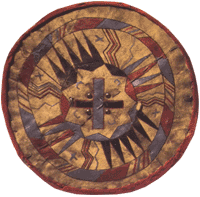





The Shoshone, Shoshoni or Snake are a Native American group consisting of several bands. They are closely related to the Paiutes, Comanches, and the Utes and shared very similar languages. The Shoshone lived in a wide area around the Great Basin and Great Plains areas in a number of bands headed by chiefs with shifting membership. The Shoshone adopted a horse culture but had trouble competing with tribes to their east who had better access to European trade and weapons. The tribe was party to the Fort Bridger Treaty Council of 1868. Famous tribe members include Washakie, Sacagawea who guided the Lewis and Clark expedition, and Pocatello whose name was used by the city of Pocatello, Idaho.
There are three large divisions of the Shoshone - the Northern, the Western and the Eastern. The Northern concentrated in eastern Idaho, western Wyoming, and north-eastern Utah. The Eastern lived in Wyoming, northern Colorado and Montana. Conflict with the Blackfoot, Crow, Sioux Cheyennes, and Arapahos pushed them south and westward after about 1750. The Western ranged from central Idaho, northwestern Utah, central Nevada, and in California about Death Valley and Panamint Valley. This group is sometimes called the Panamint. The Idaho groups of Western Shoshone were called Tukuaduka, or Sheep Eaters while the Nevada/Utah ones were called the Gosiute and the Toi Ticutta (cattail eaters).
The estimated population of Northern and Western Shoshoni was 4,500 in 1845. 3,650 Northern Shoshoni and 1,201 Western Shoshoni were counted in 1937 by the United States Office of Indian Affairs.
The Northern Shoshone fought conflicts with settlers in Idaho in the 1860s which included the Bear River Massacre and again in 1878 in the Bannock War. They fought with the U.S. Army in the 1876 Battle of the Rosebud against their traditional enemies, the Lakota and Cheyenne.
